February 1, 2008
Air Date: February 1, 2008
FULL SHOW
SEGMENTS
Obama on Climate Change
/ Jeff YoungView the page for this story
Living on Earth's Jeff Young takes a hard look at Senator Barack Obama's record and platform on global warming. Environmentalists generally give him high marks. But they also raise a few questions about the Illinois senator's connections to the coal and nuclear industries. (10:15)
Note on Emerging Science
/ Mitra TajView the page for this story
Solar-powered threads could be the future of wardrobe design, at least for the military. Mitra Taj reports. (01:45)
Cyber Security Breach
View the page for this story
As power companies increasingly use the internet to manage their power grids, they’re also becoming increasingly vulnerable to hacker attacks that could shut down power and destroy facilities, all with the click of a mouse. Host Bruce Gellerman speaks with Alan Paller, director of research at the SANS Institute, which specializes in security systems education. (05:00)
Energy up in Smoke
View the page for this story
Enough wasted heat energy escapes from industrial smokestacks each year to replace 120 coal plants. Thomas Casten, chairman of Recycled Energy Development, explains to host Bruce Gellerman that the only thing stopping recycled heat technology from taking off is outdated federal and state laws. (06:30)
Swedish Body Heat
/ Aarni KuoopamakiView the page for this story
The body heat from the hundreds of thousands of commuters who use Stockholm’s Central Station will be harnessed to heat a nearby office building. Deutsche Welle Radio’s Aarni Kuoopamaki reports. (06:20)
Diamonds to Rice
View the page for this story
A non-governmental organization teams up with Sierra Leonians to rebuild their war torn country - planting rice fields where once lay the raw earth remnants of conflict diamond mining. Host Bruce Gellerman speaks with Darci Glass-Royale, executive director of FESS, the Foundation for Environmental Security and Sustainability, and Daniel Gbondo, a Sierra Leonian who works for FESS in his home country. (06:50)
Psychogeography
View the page for this story
Author Will Self walks the world to explore what's underfoot and what really matters. He talks with host Bruce Gellerman about his new book “Psychogeography: Disentangling the Modern Conundrum of Psyche and Place.” (09:30)
This week's EarthEar selection
listen /
download
Bringing in the sheep in Devon, England.
Show Credits and Funders
Show Transcript
HOST: Bruce Gellerman
GUESTS: Tom Casten, Daniel Gbondo, Darci Glass-Royale, Gene Karpinski, Alan Paller, Will Self
REPORTERS: Aarni Kuoopamaki, Jeff Young
NOTE ON EMERGING SCIENCE: Mitra Taj
[THEME]
GELLERMAN: From Public Radio International - this is Living on Earth.
[THEME]
GELLERMAN: I’m Bruce Gellerman. Old King Coal was a merry old soul - but could he bring grief to Barack Obama?
O’DONNELL: The guy has got on the whole a great platform, he’s raised some questions because of his flirtation with coal. And so people were raising the question, isn’t he at least a bit uncomfortable to be consorting with coal company types?
GELLERMAN: Also - his shoes are made for walking - and boy that’s just what he does. London to Manhattan - with a mind-numbing plane ride in between.
SELF: There’s no reason why they couldn’t put much bigger windows in planes. There’s no reason why the stewardesses shouldn’t wear ride of the Valkyrie helmets and the captain shouldn’t shout over the PA “Whee” as you take off.
GELLERMAN: Psychogeography - exploring the contours of your mind with your feet. Those stories and more - this week on Living on Earth. Stick around!
ANNOUNCER: Support for Living on Earth comes from the National Science Foundation and Stonyfield Farm.
[THEME]
Obama on Climate Change

(Photo: Flickr/an agent)
GELLERMAN: From the Jennifer and Ted Stanley Studios in Somerville, Massachusetts - this is Living on Earth. I’m Bruce Gellerman, in for Steve Curwood.
And then there were two. It’s down to Senators Barack Obama and Hillary Clinton in the democratic presidential primaries.
All along the campaign trail, voters have been asking the candidates how they plan to tackle global warming. Here at Living on Earth, we’ve been asking presidential hopefuls the same question – this week it’s Barack Obama's turn. His plan wins high marks from some environmentalists. But his connections to the coal and nuclear industries also raise a few eyebrows. Living on Earth’s Jeff Young has our report.
[CHEERING AT DEMOCRATIC NATIONAL CONVENTION]
YOUNG: Boston, July 27, 2004: the democratic national convention. In just a few hours, a self described skinny guy with a funny name, Barack Obama, will deliver an electrifying keynote speech here, catapulting him from obscure state senator to national political prominence.
But first, Obama visits Boston harbor, and a small crowd of environmental activists. He thanks them for making his U.S. Senate run possible.
OBAMA: Now we had a lot of important moments in this race, but one of the key moments was when we got the support of the League of Conservation Voters.
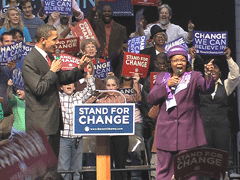
Senator Obama rallies in Greenwood, South Carolina.(Photo: Flickr/Obama)
KARPINSKI: When we got in the race, I think he was in third or fourth place in a multi-candidate primary. But we invested heavily in that race, we touted his environmental record, he won that primary, and then he won going away in the general. So we really had a new friend in Congress, a new leader in Congress on the environment, that we really helped get there.
YOUNG: Do you feel that investment has paid off? Has Senator Obama lived up to your expectations as a senator?
KARPINSKI: Well clearly Senator Obama’s record since he’s been in the Senate has been very, very strong. His lifetime score is a 96 percent. It’s been very strong particularly as he’s been campaigning on the most important issue, the issue of global warming.
OBAMA: The days of debate about whether the globe is getting warmer are over. There are about two holdouts left in the Bush white house.
YOUNG: On the campaign trail Obama makes frequent mention of his global warming plan, but rarely goes into details. He would use a cap and trade law with aggressive targets to cut greenhouse gas emissions 80 percent below 1990 levels by mid century. Obama would make polluting companies purchase the credits to emit CO2. He’d use that money to invest in green technology and help low-income people meet energy needs. He also sets ambitious targets for energy efficiency and renewable electricity. As for transportation fuels, he’d push a low carbon fuel standard.

Sen. Barack Obama spoke at a rally for senate candidate Jim Pederson at Arizona State University on Nov. 12. (Photo: Flickr/basile12)
[CHEERS FADE OUT]
YOUNG: That sounds good to environmentalists. But it doesn’t sound all that different from his Democratic competitor Hillary Clinton. Bob Sussman, a former high-ranking official in President Bill Clinton’s Environmental Protection Agency is now an environment advisor to the Obama campaign.
SUSSMAN: Well I wouldn’t say that the platforms are dramatically different, at least as compared to Senator Clinton. One thing that sets Senator Obama apart is his long-standing commitment to these issues. These are issues that he has worked tirelessly on since his days in the Illinois state legislature.
YOUNG: As a state senator, Obama got a perfect score from Illinois environmental watchdogs. And in his first year in the US Senate, Obama faced tough choices on the environment. For example, labor and industry groups from the coal-producing region of southern Illinois wanted Obama to support the Bush administration’s Clear Skies proposal. Environmentalists, like Karpinski, said it would weaken clean air protections.
KARPINSKI: Certainly Senator Obama was getting a lot of pressure from the down-state coal industry, but to his credit we worked closely with him, and he became a real champion in opposing the Clear Skies - the so-called Clear Skies Act from President Bush.
YOUNG: However, Obama has come under fire for voting with Republicans on an energy bill in 2005. It gave massive subsidies to many forms of energy, including nuclear power. Obama defended that vote to Tim Russert during this presidential debate broadcast by MSNBC.
RUSSERT: Did you realize when you were voting for that energy bill, that it was going to create such a renaissance of nuclear power?
OBAMA: Well, the reason I voted for it was because it was the single largest investment in clean energy - solar, wind, biodiesel - that we had ever seen. Now, with respect to nuclear energy, what I have said is that if we could figure out a way to provide a cost-efficient, safe way to produce nuclear energy, and we knew how to store it effectively, then we should pursue it because what we don't want is to produce more greenhouse gases.
YOUNG: Obama’s also proposed a controversial use of coal. Last year, he co-sponsored a bill to make a liquid fuel from coal that could be used as a gasoline substitute.

AUSTIN, TX - Sen. Barack Obama speaks to a crowd of about 15,000 in the light rain at Auditorium Shores. (Photo: Flickr/an agent)
YOUNG: That’s Frank O’Donnell of the group Clean Air Watch. Obama later said he would only support liquid coal if the final product produced less CO2 than gasoline. But O’Donnell says the liquid coal bill is not Obama’s only coal connection.
O’DONNELL: For example, in Nevada one of his advisors was a fellow named Vasiledes, a PR man who was also simultaneously the PR man and ad man for the coal lobby’s attempt to make itself look good. And so people were raising the question there, isn’t he at least a bit uncomfortable to be consorting with coal company types?
YOUNG: The clean coal public relations crews have become regulars at Obama campaign rallies. I ran into Tim Kelly outside an Obama event. He was wearing a T-shirt showing a power cord plugged into a lump of coal.
KELLEY: It’s America’s power. What we do is we promote clean coal technology and the continued use of coal in producing electricity. This is probably the second or third Obama rally I’ve been to, and Obama’s supportive of some of our same goals. He believes we have to continue to use coal.
YOUNG: But Obama campaign advisor Bob Sussman says critics like O’Donnell are making too much of a few industry connections.
SUSSMAN: Well I don’t think there’s much of a connection there to worry about.
YOUNG: Sussman himself aside from working at the EPA, spent much of his career as a lobbyist and lawyer for the firm Latham and Watkins. The firm represented coal power companies in their attempts to influence Bush administration rules on mercury emissions and changes to the clean air act.
SUSSMAN: That’s true. I did work for different folks in the energy industry, and I don’t consider that to be a bad thing, but it’s not a factor at all in anything that I’m doing for Senator Obama now. Senator Obama’s been very clear that he doesn’t want lobbyists involved in his campaign. That’s an excellent line to draw, but people who have worked for industry understand how industry works, and have expertise on these issues, have an awful lot to contribute and they should have a seat at the table along with everybody else.
YOUNG: And that’s an argument that O’Donnell at Clean Air Watch says he can understand when he sums up Senator Obama’s environmental record.
O’DONNELL: The guy has got on the whole a great platform. He’s raised some questions because of his flirtation with coal, and it may be his flirtation with coal may be a microcosm of the reality that you can’t deal with some of these issues like global warming without giving a nod to coal. Now a lot of us wish that weren’t the case, but maybe that’s the practical reality as things ultimately unfold.
YOUNG: After all, coal, which provides about half the country’s electricity, is not likely to go away any time soon. For Living on Earth, I’m Jeff Young in Washington.
GELLERMAN: Hey Jeff, stick around for a moment, okay. I want to talk to you about what’s happening in the republican race, because global warming has been getting some pretty prominent play there, too.
YOUNG: It has. Mitt Romney has really been going after Senator McCain on this. Of course, McCain was the first to propose a cap on carbon emissions, and Romney’s really been on the attack, saying this means McCain’s not a real conservative. He’s putting the economy at risk through increasing energy prices. McCain shoots back that he will trust American entrepreneurs to rise to this challenge and create green energy jobs.
GELLERMAN: So what effect if any do you think this is having?
YOUNG: I think it’s having a big effect, and I think McCain comes out the winner on the whole on this. And the way that’s paying off for him is in the form of some very important endorsements in some very key states.
GELLERMAN: You mean like California Governor Arnold Schwarzenegger endorsing John McCain?
YOUNG: That’s exactly what I mean, and you know the symbolism of the setting of that endorsement could not be more important. They were touring a solar power facility when Schwarzenegger makes his endorsement of John McCain, underscoring the importance of tackling climate change, and creating these you know green energy jobs. And this also paid off for McCain in Florida, where Governor Charlie Christ, another Republican who has taken action to cap greenhouse gases, focus on green energy, endorsed John McCain. And it’s a big reason why John McCain won Florida. It seems unlikely, but I really think that global warming is turning into the stealth issue, and it’s a big part of who’s going to win the Republican nomination.
GELLERMAN: Hmm, Interesting. Well thanks a lot, Jeff.
YOUNG: You’re welcome.
GELLERMAN: Living on Earth’s Washington correspondent Jeff Young. And be sure to check out our website, L-O-E dot org, for our coverage of the presidential race and the environment.
Related links:
- Sen. Obama's campaign campaign website has details on his global warming and energy plan
- More about the candidates' environmental records from the League of Conservation Voters
- The campaign finance site Open Secrets has information on Obama campaign advisor Robert Sussman's work as a lawyer and lobbyist
- Check out LOE's full election coverage, including profiles of the leading candidates
[MUSIC: Don Fleming “Sound as Steel” from “guitarrorists” ( no. 6 records 2001)]
GELLERMAN: Just ahead—turning smokestacks into cash cows. But first this note on emerging science from Mitra Taj.
[BATTLEFIELD SOUNDS: Sound Effects, Volume Nine/Ten (Gateway Recordings)]
Note on Emerging Science
TAJ: In the battlefield of the future, the uniform might make the soldier.
Modern warfare has become increasingly battery powered - with night-vision goggles, networked computers, and laser-range finders essential to basic missions. Indeed, the average U.S. soldier needs 88 AA batteries for a five-day mission. But new technology—and the sun—might help lighten the load.
[SCIENCE NOTE THEME]
Researchers in Florida have made a machine for the military that can weave threads made of solar-powered batteries into cloth. This cloth can be made into uniforms to unburden foot soldiers of heavy battery packs and reduce the need for battery changes in the middle of combat.
By controlling the temperatures of materials separately, the machine can spin threads—out of polymers, metals, and maybe even genetically engineered viruses—into intricate nanoscale patterns.
Some of these threads are a fraction the thickness of a human hair. When they’re made out of battery electrodes and photovoltaic and fuel cells and then stitched together, they constitute a fabric that captures and stores energy while it’s worn.
The new technology might help in civilian life too, boosting efforts to make environmentally friendly power sources that multitask—imagine a jacket that keeps you warm while charging your cell phone.
If wearable power catches on, keeping connected in the future might be as easy as getting dressed in the morning and staying on the sunny side of the street.
That’s this week’s note on emerging science. I’m Mitra Taj.
GELLERMAN: Stay tuned to Living on Earth.
[MUSIC: Choro Ensemble “Zanzando em Copacabana from “Nosso Tempo” (Anzic Records 2007)]
Cyber Security Breach
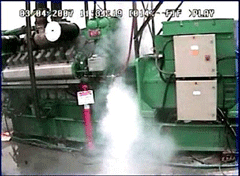
Generator room at the Idaho National Laboratory was remote accessed by a hacker and a $1 Million diesel-electric generator destroyed. (Courtesy of U.S. Department of Homeland Security)
GELLERMAN: It’s Living on Earth, I’m Bruce Gellerman. The CIA’s top Cyber Security analyst recently made a very unusual and alarming public statement. According to the agency’s Tom Donahue, computer hackers tried to infiltrate and disrupt the electric power grids in several foreign regions. And in some places, they succeeded. Who hacked the grids? Where? How? We don’t know. The tight-lipped CIA isn’t talking.
But Alan Paller is - he’s the director of research at the SANS Institute, which is a cyber security education organization. It was Paller who chaired the mid-January meeting where the CIA’s Tom Donahue made his startling announcement.
PALLER: I was shocked, because he had spoken for us at an earlier conference about a year and a half ago and swore us all to secrecy. We couldn’t tell anyone the kinds of things he was saying, and when he walked into this meeting he said ‘I’m going to say something we’ve never disclosed before and you can quote me.’
GELLERMAN: Why would he make this kind of dramatic statement - especially from the CIA?
PALLER: This all is guesswork. Tom didn’t say ‘hey, I’m doing it for this particular reason.’ He did say he vetted it with all of the senior people, which means that there was a systematic analysis of whether or not it should be disclosed. And the only answer that I could give you is that the problem had become great enough that they wanted the utilities to actually act on it rather than just talk about it.
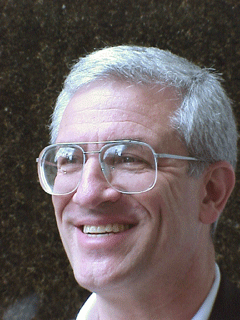
Alan Paller, Head Researcher at the SANS Institute.(Courtesy of SANS Institute)
PALLER: Because the heads of utilities get lied to by their technical people. The technical people say ‘oh, nobody can get in! We’re not connected to the Internet.’ But we had three people at that same meeting who, for a living, did penetration testing of utilities, and every one of them said they never failed to get in, even when the organization claimed they weren’t connected to the Internet. They just don’t know all the connections they have.
GELLERMAN: So how do hackers do it? How would they take down a power supply?
PALLER: Lots of steps, but one of them is to get into the computers and that turns out to be much easier than anybody thinks. In fact, the Government Accountability Office had two reports on how much easier the utilities have made it for hackers to get in by starting to use Windows operating systems and connecting their systems to the internet. So, they can get in through the business side and then they jump over to the control systems side. And then once they’re in the control system side, they have to learn a lot about the control systems. But it turns out that over the last year and a half in the very sophisticated hacker conferences, people have been giving speeches about how to hack these sophisticated control systems. They’ve bought them on eBay, they’ve found the manuals for them, they’ve figured out how to hack them, so not only am I confident that it happened but I’m confident it’s going to happen substantially more in the future.

Generator room at the Idaho National Laboratory was remote accessed by a hacker and a $1 Million diesel-electric generator destroyed. (Courtesy of U.S. Department of Homeland Security)
PALLER: It was actually the second test like that. The first test was one in which they caused a chemical spill in a chemical plant from a remote hack. This was the second one where they demonstrated that a generator could actually be destroyed. And this is new for most people. The idea that physical damage can be done by cyber attack but that’s what those two tests demonstrated beyond any doubt.
GELLERMAN: So, a terrorist could sit in a cyber café anywhere in the world, type in a couple of codes, and take down a power plant?
PALLER: It’s as hard to do this as to learn to fly an airplane into the 82nd floor of a tall building in New York. So my point is, no, anyone can’t do it but if you have enough money, enough time and enough will, you can learn to do it. And it’s not any harder to do this than it is to fly a jetliner.
GELLERMAN: Well, just around the time that the CIA was announcing this hack, a governmental agency announced, well it was coming out with eight mandatory measures to plug cyberholes.
PALLER: They did, indeed. That organization is called FERC, Federal Energy Regulatory Commission. And all they were doing was approving a set of measures that the industry association, the association of utilities, wrote. And it turns out that those measures are not very effective because they don’t measure actual security of the systems, they measure whether or not people have written reports about security.
GELLERMAN: So, are we any better off now than we were before these eight mandatory measures came out?
PALLER: The people who helped develop them claim that it’s a step in the right direction. And my answer to that is: it’s a step in the right direction but we’re way past the point at which we need to take baby steps. We need to take big steps to protect these utilities and we’re not doing it. It turns out that almost no utility has the security expertise to protect its control systems. The only ones who do have that knowledge are the ones who manufacture those control systems. So we need to shift the responsibility to those manufacturers, and we’re going to have to pay them a little bit to do it. But we need them to take responsibility for securing the systems.
GELLERMAN: Well Mr. Paller, thank you very much. I appreciate your time.
PALLER: And thank you.
GELLERMAN: Alan Paller is the Director of Research at the SANS Institute, a cyber security education organization that works with government agencies and corporate clients.
Related links:
- The SANS Institute
- The Government Accountability Office's report on Cyber Security Risks
- The Federal Regulatory Energy Commission approved new reliability standards for cyber security earlier this month
Energy up in Smoke
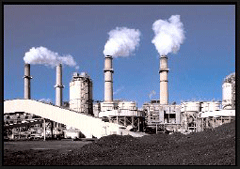
Heat from smokestacks like these can be recycled to create electricity without burning additional fossil fuels. (Courtesy of the EPA)
GELLERMAN: Even in post-industrial America, smokestacks still define our landscape. There are half a million smokestacks in the U.S., and nearly 48,000 emit heat above 500 degrees Fahrenheit. To Tom Casten that’s energy literally going up in smoke. His company RED sees a lot of green in capturing it. Casten is chairman of the Illinois-based company Recycled Energy Development – RED. RED buys industrial power plants, recaptures waste heat and then sells the power back to the original company at a discount. Now RED wants to expand and sell excess power back to the grid.
Thomas Casten joins me from the studios of WBEZ in Chicago. Hello Mr. Casten!
CASTEN: Hello Bruce, thanks for having me.
GELLERMAN: You’re very welcome. So, how much energy is going up in smokestacks?
CASTEN: We have an EPA study that says we could make 20 percent of all U.S. electricity by simply capturing the energy that industry wastes using proven technology. Probably could get to 30 percent with some slight new development of technology.
GELLERMAN: So, 20 percent savings. How many nuclear power plants would that be?
CASTEN: About 65 nuclear stations, which is half the U.S. fleet, could be eliminated. You wouldn’t eliminate them, you’d, instead you’d eliminate something like 120 coal plants.
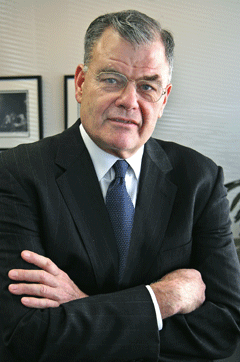
Thomas Casten is chairman of the Illinois-based company Recycled Energy Development (Courtesy of Recycled Energy Development)
CASTEN: Bruce, the technology is very old and it’s the same technology that the power plants use. We basically use the heat to boil water and make steam, we use the steam to drive a turbine, which is the same thing that every nuclear, coal or gas plant does, and the turbine drives an electric generator. The only difference is they burn fuel and release emissions and we don’t. The plants that we build don’t use any fossil fuel. They simply recycle the waste energy out of these stacks you’ve described or other forms of waste energy, and greatly improve the energy productivity.
GELLERMAN: So what’s new with RED?
CASTEN: We are reaching a point where the options for new power are suddenly very much more expensive. What we’ve had happen - coal has tripled in price, gas has quadrupled in price, and all of the new options for power are up in the ten cents a kilowatt hour range. And our projects make sense at five to six cents a kilowatt hour so we’re entering an era where, if the regulators and the politicians will just give clean energy a chance, climate change mitigation will turn into a big economic opportunity.
GELLERMAN: Okay, so, what am I missing?
CASTEN: Meaning it’s too good to be true?
GELLERMAN: Right.

Heat from smokestacks like these can be recycled to create electricity without burning additional fossil fuels. (Courtesy of the EPA)
GELLERMAN: So what one rule, on the federal level, would you like to see change?
CASTEN: The federal Clean Air Act makes improving energy productivity effectively illegal. Once you have a permit for a plant, if you modify it to make it better you lose your permit and you have to go back in and get a new permit based on the latest possible technology. And this has frozen the efficiency of all of our heat and power plants since 1976. It is a disastrous rule. We make energy productivity illegal in the largest industry in the country.
GELLERMAN: So you don’t want to scuttle the Clean Air Act.
CASTEN: Oh, I’m an environmentalist who tries to make my living as a capitalist. I want to have those rules be as cost effective and as environmentally effective as possible. My larger comment is that global warming is such a huge problem; it’s hard to believe we’re going to solve it if our only answer is that people must make sacrifices. We’re offering an approach that profitably reduces greenhouse gases and that’s much easier to persuade people to do - to go improve their own economic lot and do good. We just need to be a little smarter about how we’re doing these things.
GELLERMAN: So if you could change one state rule - you’re in Illinois - what would it be?
CASTEN: Each state gives monopoly protection to the distribution and often the generation of electricity. So this giant industry is not subject to competition like everybody else. What is the most important question in energy? Why has electric generation not improved since Eisenhower? And I believe it hasn’t improved for two reasons: number one, it’s protected from competition by each state; and number two, the federal approach to clean air makes improving efficiency illegal. That’s bad news. But the good news is, those rules were made by human beings. They can be changed. So we change the rules, and we’ll have a little economic boom on our hands.
GELLERMAN: How big can this get?
CASTEN: We’ve estimated that there could be 350 billion dollars spent in the United States on new, efficient, local power plants that recycle energy, and that that would reduce U.S. energy costs by about 70 billion dollars per year, and it would slash total U.S. greenhouse gas emissions by 20 percent for the whole country. It would put the U.S. below the Kyoto level and we’d save 70 billion dollars. So this has the possibility of solving many of America’s problems, not just the environmental problem, but defending against foreign energy supplies and keeping jobs here. One of the things that happens when you do this is that the manufacturer gets an extra revenue stream and cuts its costs. I’m just not willing to say ‘well, the Chinese have lower standards and cheap labor and so they’re going to do all the manufacturing and we’re all going to be Wal-Mart greeters.’ We have brains and a terrific entrepreneurial system and this is a way to apply those brains and return our manufacturers to competitiveness
GELLERMAN: Well Mr. Casten, thank you very much. Good luck.
CASTEN: Thank you, Bruce.
GELLERMAN: Thomas Casten is chairman of Illinois-based Recycled Energy Development: RED.
Related link:
Recycled Energy Development
Swedish Body Heat
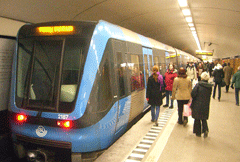
Stockholm's T-bana subway system. (Photo: Flickr/James Cridland)
GELLERMAN: And now another story about harvesting waste heat – this time in Stockholm, Sweden, where the average winter temperature is below freezing. Commuters in Stockholm’s Central Station bundle up to fend off the frigid clime. Now, there are plans to use the heat their bodies generate in the station to warm a nearby building. Deutsche Welle Radio’s Aarni Kuoopamaki has our report.
[SOUND OF TRAIN ARRIVING, CONDUCTOR ANNOUNCEMENT]
KUOOPAMAKI: Two hundred and fifty thousand people arrive at Stockholm Central Station every day. Mostly, they are in a hurry. Since the Central Stakhun, as the locals call it, connects commuter trains to the municipal subways system. As the travelers race from one platform to the other in their thick winter jackets, their skins work like a giant radiator. One breath has a volume of about half a liter. Two hundred fifty thousand breaths - that’s taking account of only one for each commuter in every train - amount to about 135 cubic meters. And this is more than just air; it’s energy. And energy is money, explains construction manager Karl Sundholm.
SUNDHOLM: This building doesn’t really need heating because of all the people in here. We’ve got plenty of heat here that we actually just get rid of it out in the air. So instead of getting rid of that, we pump it over to that building over there, ja? See it there?
KUOOPAMAKI: He’s pointing to a flat gray building squatting above the railway tracks.
SUNDHOLM: You can see that all their windows are taken out and we’re beginning to tear it down from the ceiling.
KUOOPAMAKI: It’s not really beautiful I must say.
SUNDHOLM: No, it’s a quite ugly one. It’s actually been named one of Stockholm’s ugliest houses. It’s like 25 years old but it’s got very bad isolation and it’s very low to the roofs and so it’s a bad building. We have tried to figure out how we could use it in other ways but—no way. We found out that the best thing is to tear it down and build a new building up.

Stockholm's T-bana subway system. (Photo: Flickr/James Cridland)
SUNDHOLM: It’s just a couple of pumps and some pipes. There’s no special things needed. No rocket science, as somebody said.
KUOOPAMAKI: The recovery of body heat will provide about 15 percent of the heating and energy needed for the 13-story, 40,000-square-meter Kundt’s brew house. The building will have a parking lot and a hotel underground, shops at street level, and office space on the top. It will be finished in 2010, but Karl Sundholm already sees the ecological system as a way of attracting tenants.
SUNDHOLM: This could be something that the ones who rent these offices could use as a marketing thing for themselves and for their customers. We’re sitting in this house and we don’t use as much energy that we would if we sat in another house. So, we’re going to try to help the offices to work with their environmental issues as well.
KUOOPAMAKI: Everybody is supposed to profit from the energy recycling, not the least the environment. Therefore, the commuters providing the energy seemed more than happy to contribute their body heat free of charge.
MAN: To use people’s heat to heat up a building? Sounds nice.
MAN 2: Ah, that’s a good one! Environmentally friendly, no?
WOMAN: Two hours ago I was watching a movie about global warming so I think that’s a good idea.
MAN 3: Every part counts, doesn’t it? Just every bit helps.
WOMAN: I mean, you get it for free, so yeah, why not?
MAN 3: I think that’s a very innovative and creative solution and it’s cost effective and also it doesn’t create much of an adverse effect to the environment at all so I would say it’s a pretty good way to go. As long as the government is not taxing us for that!
KUOOPAMAKI: From the Central Stakhun, it’s only a few hundred meters to the Swedish Ministry of the Environment. Political advisor Hanes Bury offers us visitor water from the tap. The minister has abandoned bottled water because its transport causes unnecessary carbon dioxide emissions. It’s merely a small gesture among a multitude of measures to protect the climate. All in all, this strategy seems to be successful, explains Bury.
BURY: Sweden is one of the few countries in the Western world that’s managed to decrease our emissions of carbon dioxide meanwhile the economy has grown. So we have managed to decouple emissions and economic growth.
KUOOPAMAKI: In Sweden, the yearly amount of emissions can vary quite a bit, depending on the winter. In the cold northern climate, heating takes up a lot of the total energy consumption. Therefore, the Swedes rely on district heating in urban areas, where heat is distributed to the homes from a single energy efficient plant. Body heat was first recycled in prototype houses, then in public buildings. This latest step takes it from one building to another. But the Swedes, says Hanes Bury, want to do more than that.
BURY: On a global scale we only account for 0.2 percentage of the carbon emissions but one of the ambitions of the Swedish government is to establish good examples and good technologies for technology transfers to other countries. For example, if we can use our examples in district heating and renewable fuels and use them in, for example, China, where they build a new coal plant every week, then we can maybe take part in helping out with a solution on the global level. It’s not enough just to solve the problems at home. We have to help with global solutions as well.
[SOUND OF SOMEONE RUNNING, BREATHING]
KUOOPAMAKI: Knowing this, commuters in Stockholm Central Station can sit down to relax in the train, sweaty but happy to have done a good deed for the environment.
Related link:
Deutsche Welle Radio’s “Living Planet”
[MUSIC: Deborah Henson-Conant “It’s About Time” from “On the Rise” (GRP Records, Inc. 1989)]
GELLERMAN: Our piece on hot Swedes came to us from Aarni Kuoopamaki, courtesy of Deutsche Welle Radio.
Coming up, diamonds are for never - rice will suffice. Stay tuned to Living on Earth.
ANNOUNCER: Support for the environmental health desk at Living on Earth comes from the Cedar Tree Foundation. Support also comes from the Richard and Rhoda Goldman Fund for coverage of population and the environment. This is Living on Earth on PRI: Public Radio International.
[MUSIC: James Newton Howard, soundtrack from “Blood Diamonds (Varese Sarabande Records 2006)]
Diamonds to Rice

Diamond mining at the Tankoro site in Sierra Leone. (Photo: FESS)
GELLERMAN: It’s Living on Earth, I’m Bruce Gellerman. One of the poorest nations on the planet is also one of the richest in diamonds. And for that - Sierra Leone has paid a price in blood.
In the 1990’s the country’s diamond mines fueled a decade of terror, a vicious civil war fought for control of the nation’s mineral wealth. It’s a war many of us know about, but only because of a Hollywood film - “Blood Diamond.”
Seventy-five thousand people were killed in Sierra Leone, tens of thousands maimed and nearly a third of the population driven from their homes. Now the mud-pit diamond mines, which caused so much suffering, are being transformed into fields of rice. The effort is being led by the Foundation for Environmental Security and Sustainability, or FESS. It gets most of its funding from the U.S. Agency for International Development.
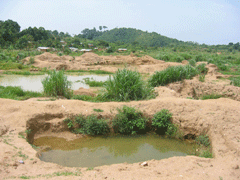
Damaged land to be reclaimed at the Tankoro site.(Photo: FESS)
GLASS-ROYAL: Thank you. Thank you for inquiring about the work that we’re doing in Sierra Leone.
GELLERMAN: Ms. Glass-Royal is in New York City now, traveling with Daniel Gbondo who is the head field organizer for FESS in Sierra Leone and a Sierra Leonean himself. Mr. Gbondo, welcome to Living on Earth.
GBONDO: Thank you very much and thank you for hosting us.
GELLERMAN: Let me ask you Ms. Glass-Royal first: how do you turn a diamond mine into a rice field?
GLASS-ROYAL: It’s a bit of a challenge. After many years of digging the area is left incredibly pitted. It looks like the surface of the moon, if the moon had villages. And what we have done is gone through an extensive process working with local communities to hire workers so that we can begin filing in the soil and take areas of land that are not productive and return them to agriculture.

Reclaiming land at the Tankoro site. (Photo: FESS)
But it was our goal to say that in an area that, because of the rich volcanic soil, can be so agriculturally productive, an area that used to be the breadbasket of West Africa, that there was just no way that the country could continue to grow economically and feed its people without returning to agriculture.

Diamond mining at the Tankoro site in Sierra Leone.(Photo: FESS)
GBONDO: The township was completely destroyed. I mean, systematic burning of houses - by street by street, house by house. And some houses were bulldozed and mined and streets were mined for diamonds. Diamonds actually fueled the conflict in Sierra Leone at the time and there was just indiscriminate mining all over the place - destroying the streets, destroying the environment.
GELLERMAN: And I understand that you actually lost some people very close to you during the civil war.
GBONDO: Oh, yeah. My elder brother worked in the diamond mines. He was killed during the civil war. My father was killed during the civil war.
GELLERMAN: How many acres have you been able to convert?

Many of the workers reclaiming the pits fought in the civil war, or are former diamond miners.(Photo: FESS)
GELLERMAN: Daniel, can you tell me a story about someone who’s been influenced by your work? Maybe someone who you know who’s been helped to recover from the civil war because of this project?
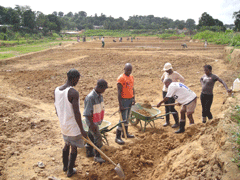
Creating swamp rice field at the Tankoro site.(Photo: FESS)
GELLERMAN: Mr. Gbondo, it seems to me you’re in a unique position. I mean here you are working for this NGO, this nongovernmental organization, and you bring together the two worlds. You’re helping your country in the process and you can join it with kind of this Western association.
GBONDO: For me, I see myself lucky in a way to be part of this. Talking to my American friends, you talk to them about Sierra Leone and all they know is the “Blood Diamond” movie—‘oh, these guys are just good at killing people.’ But this project is telling the other side of the story. That there are efforts out there to address the problems associated with diamond mining—environmental problems, social problems, health risk in Sierra Leone. And I see this as an opportunity that I am part of it: one, to help transform my society, and two, to help spread a message that there is another side to diamond mining in Sierra Leone.
GELLERMAN: It seems to me, Ms. Glass-Royal, that this project isn’t just about land use.
GLASS-ROYAL: This project is about transforming communities and bringing stability and growth to a fragile but very critical part of the world.
GELLERMAN: Darci Glass-Royal is the co-founder and executive director of the Foundation for Environmental Security and Sustainability. Daniel Gbondo is the head field organizer for FESS in Sierra Leone. Well I want to thank you both very much for joining us.
GLASS-ROYAL: And thank you for hosting us.
GBONDO: Thank you very much for having us here.
Related links:
- FESS: Foundation for Environmental Security and Sustainability
- To read the FESS report on "Improving Environmental Management and Mitigating Land-Use Conflicts in Alluvial Diamond Fields in Sierra Leone" click here.
[MUSIC: Deborah Henson-Conant “Under the Bed” from “On the Rise” (GRP Records, Inc. 1989)]
Psychogeography

"Psychogeography: Disentangling the Modern Conundrum of Psyche and Place" (Photo: Bloomsbury USA)
GELLERMAN: A few years ago novelist and journalist Will Self decided to take a walk. He walked from South London, where he lives, to the Lower East Side of New York City. Oh he took a plane alright - from Heathrow to JFK, but Will Self walked from city to airport and airport to city, practicing what’s called “psychogeography.”
Will Self may be the world's foremost practitioner of psychogeography - in fact today he may be one of its only practitioners. In his latest book, he invites you to meander with him. It’s called "Psychogeography: Disentangling the Modern Conundrum of Psyche and Place." The book’s a collection of essays about Will Self’s wandering by footmobile. Will Self joins us from the BBC studios in London. Will, it’s good to have you on the show!
SELF: How do you do?
GELLERMAN: You’re in a BBC studio in London, right?
SELF: Yes, I am. Indeed.
GELLERMAN: Did you walk there?
SELF: I did [laughs] I did walk here. I would have cycled but I have a new dog and the dog needed to walk.
GELLERMAN: How far is it?
SELF: Oh, it can’t be much more than a mile and a half, something like that.
GELERMAN: Oh, so that’s just a walk around the block for you.
SELF: Mmm hmm. Mmm hmm.
GELLERMAN: So what is pyschogeography?
SELF: Well the term derives from the French situationalists and specifically from a man called Guy Debord. And he said that, you know, modern society is a kind of spectacle, and specifically modern cities are defined and we start to see them as a function of our human geography - where we eat, where we sleep, where we buy, where we go to work. And we can no longer see them for what they are. So his idea was that, that pyschogeography would in some way deconstruct the urban environment - we’d start to see cities for what they really are again rather than what the powers that be want us to see them.
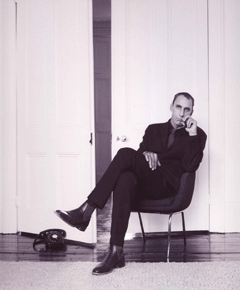
Will Self (Photo: Bloomsbury USA)
SELF: Absolutely. I mean, Debord and the original situationalists used to practice what they called the ‘derive,’ which basically consisted of meeting up at the Parc des Buttes Chaumont in the north of Paris, buying a few cheap bottles of red wine, getting drunk, and drifting down to the Ile de la Cite in the Seine where they’d sleep it off.
GELLERMAN: Well how does walking to an airport, getting on a plane, and then walking from the airport to the city - how does that illustrate what psychogeography is about?
SELF: Well, it does it in many, many different ways. I mean, I’ve walked from my home in central London to Heathrow Airport on three occasions now. And I think the first time I did it, I had the definite sensation that I was undertaking an active exploration more profound probably than anybody can do anywhere in the world, in the sense that I was taking a journey, using a means for that journey that probably nobody had ever, had done since the industrial era. And yet I was traveling the same kind of route, roughly, that tens of thousands of hundreds of thousands of millions of people make every year. So there’s this marvelous sense that one gets of being cut off from the mass of humanity in this very, very simple, very self-directed way. You don’t need any equipment. You don’t need any fancy accessories. You can just get out of your chair and do it and you’re instantly exploring in that way. You’re finding out new things about your environment. The business of the, what I call the airport walks goes further though, because the most curious sensation I had when I walked to Manhattan - and as you said in your introduction, I walked to Heathrow, flew to JFK, and then walked from JFK through East New York through Brooklyn, over the Brooklyn Bridge and into the Lower East Side of Manhattan. Well when I got to my hotel in Manhattan, you know, the body - I think this is kind of an aspect of evolutionary psychology - the body’s conception of space is stronger than the mental conception of space. So that three and a half thousand mile plane flight was as nothing compared to those two full days of walking. So my body was telling me that I had been walking on a continuous land mass. My body was telling me that the Thames estuary had been rammed into Long Island in a kind of unholy miscegenation of continents. And the body was far stronger than the mind. I really thought ‘wow, I’ve walked the whole way here.’ And that for me was a marvelous and epiphanic moment. It was incredibly destructive of this life that I’ve led, and I think a lot of us have led, where we’re catapulted about the globe in these aluminum and titanium tubes and we’re traveling all over the place and yet we don’t really know where we are.
GELLERMAN: It’s interesting on airplanes now, on the backs of the seat in front of you, you can see, you know, a map and you see yourself traveling virtually over this place. But, for all intents and purposes, you’re just in this hermetically sealed airplane.

"Psychogeography: Disentangling the Modern Conundrum of Psyche and Place" (Photo: Bloomsbury) USA
GELLERMAN: This line jumped at me, actually. I was surprised to read it. You write that ‘the place chooses you. It’s not so much that you choose a place.’
SELF: I’m not sure whether I mean that literally. But what I think I do mean is that - again, we live in a culture where place is sold to you. We’re kind of accessorized by place. People say ‘oh, I went to x,’ or ‘I went to y,’ or ‘the beaches are fabulous at z,’ or ‘they’ve got fantastic ethnic jewelry in p,’ and ‘why don’t you go to m?’ You know, they’re products. Places are products and travel magazines and travel journalism is by and large a catalog of these products that’s sold to us. And people acquire place as they might acquire any other object in that way, you know, their memory, their digital cameras, you know, they’re loaded up with these vignettes of place just as any collector might show you their Sevre pottery or their beer labels or whatever it is they collect. And I think that, you know, in order to have a profound relationship with place, again coming back to this idea of kind of knowing where you are, you have to look for those places that choose you in that way and say, ‘you know, you’re not going to be here for a day or so or a couple of days, you’re going to have an evolving, perhaps a lifetime relationship with me. I’m a place that you want to know about.’ And I think, you know, for all of us who, who think about, about the world, and who think about our place in it, that that’s true. That has a resonance. And when I look back over my own life, I mean - you know, a couple of the places that I’ve come to think of as kind of ‘my places’ over the years, I didn’t even like them when I went there. It wasn’t about liking. It wasn’t necessarily about having a good time. There was something more profound going on there.
GELLERMAN: Can you experience or practice psychogeography on a bicycle?
SELF: Well bicycles are interesting [laughs], interesting…technologies. I use a bicycle all the time. That’s how I tend to get around in London. I think that the problem for the psychogeographer is that they, there is something about walking. It is my absolutely preferred method of investigating place. I think it’s, it slows one down. I think walking has - it wasn’t me who coined this idea, but I think it might even have been Rousseau – I think walking has the pace of thought in that way. It has the four-four rhythm. It has a strophe and an anti strophe in that way. And I think there’s something about that. I find when I get on a cycle I tend to fall victim to wanting to get from ‘a’ to ‘b.’
GELLERMAN: Seems to me that if you’re walking to airports and getting on planes, you must be traveling pretty light.
SELF: Well, yeah, I mean, when I was in North America last year I was away for two, two and a half weeks and I didn’t take anything, at all. That was a bit extreme and I did that as a conceit in a way. I was interested in this idea of our relationship with material possessions. And I, you know, you go into airports and you see people with 22 sets of matching Samsonite luggage and you kind of think to yourself, or I do, ‘what’s going on here? Are they taking all their pants to Paraguay? Is it to show their pants to Paraguay or Paraguay to their pants?’ There’s something kind of going on here with this movement of chattels. So I was kind of reacting against that, but, you know, even ordinarily I’ve been well below a standard carry on bag for years now.
GELLERMAN: Where’s your next walk going to take you, Will?
SELF: Well, the coast of East Yorkshire in England is the fastest eroding coastline in Europe. It erodes two meters every year. So, it should be possible, unfortunately or fortunately, depending on which way you look at it, for me to take this walk down the east coast of Yorkshire, knowing that nobody will ever be able to take that walk again. That by the time next year comes, that bit of land will have gone.
GELLERMAN: Well Will, thank you very much. I really appreciate it.
SELF: It’s been a real pleasure. Thank you.
[MUSIC Charlie Hunter Trio “Special Shirt” from Mistico (Concord Music Group, Inc. 2007)]
GELLERMAN: Will Self's new book is; "Psychogeography: Disentangling the Modern Conundrum of Psyche and Place." It features 50 illustrations by gonzo graphic artist Ralph Steadman.
Related links:
- Will Self's columns in The Independent
- "Psychogeography: Disentangling the Modern Conundrum of Psyche and Place"
GELLERMAN: On the next Living on Earth, ‘Thar she blows!’
KERR: You understand your place in the wild world when you study whales. You know, we all think it’s all about humanity and yet you get out on the ocean with some of these whales, eyes the size of a grapefruit, little wrinkles. And they’re looking at you saying, you know, “you’re an intelligent species? Look at my lifestyle.”
GELLERMAN: Whales and the fate of the oceans, next time on Living on Earth.
[“Sounding Dartmoor,” John Drever]
We leave you this week in the county of Devon, in the Dartmoor National Park in the south west of England.
Local shepherds call up their border collies to bring in the sheep from the moors for shearing. This CD – Sounding Dartmoor – was recorded by John Drever.
GELLERMAN: Living on Earth is produced by the World Media Foundation. Our crew includes Ashley Ahearn, Bobby Bascomb, Eileen Bolinsky, Ingrid Lobet, Helen Palmer, Emily Taylor, and Jeff Young, with help from Jennifer Baessler and Sarah Calkins.
Our interns are Annie Jia and Margaret Rossano.
Today's show was engineered by Noel Flatt. Jeff Turton is our technical director. Alison Lirish Dean composed our themes. Steve Curwood is our executive producer. You can find us at LOE dot org. I'm Bruce Gellerman. Thanks for listening.
ANNOUNCER: Funding for Living on Earth comes from the National Science Foundation, supporting coverage of emerging science, and Stonyfield Farm Organic yogurt and smoothies. Stonyfield pays its farmers not to use artificial growth hormones on their cows. Details at Stonyfield.com.
Support also comes from you our listeners, the Ford Foundation, The Town Creek Foundation, the Oak Foundation supporting coverage of climate change and marine issues. And Pax World mutual funds, socially and environmentally sustainable investing. Pax World, for tomorrow. On the web at paxworld.com.
ANNOUNCER: PRI: Public Radio International.
Living on Earth wants to hear from you!
Living on Earth
62 Calef Highway, Suite 212
Lee, NH 03861
Telephone: 617-287-4121
E-mail: comments@loe.org
Newsletter [Click here]
Donate to Living on Earth!
Living on Earth is an independent media program and relies entirely on contributions from listeners and institutions supporting public service. Please donate now to preserve an independent environmental voice.
NewsletterLiving on Earth offers a weekly delivery of the show's rundown to your mailbox. Sign up for our newsletter today!
 Sailors For The Sea: Be the change you want to sea.
Sailors For The Sea: Be the change you want to sea.
 The Grantham Foundation for the Protection of the Environment: Committed to protecting and improving the health of the global environment.
The Grantham Foundation for the Protection of the Environment: Committed to protecting and improving the health of the global environment.
 Contribute to Living on Earth and receive, as our gift to you, an archival print of one of Mark Seth Lender's extraordinary wildlife photographs. Follow the link to see Mark's current collection of photographs.
Contribute to Living on Earth and receive, as our gift to you, an archival print of one of Mark Seth Lender's extraordinary wildlife photographs. Follow the link to see Mark's current collection of photographs.
 Buy a signed copy of Mark Seth Lender's book Smeagull the Seagull & support Living on Earth
Buy a signed copy of Mark Seth Lender's book Smeagull the Seagull & support Living on Earth

